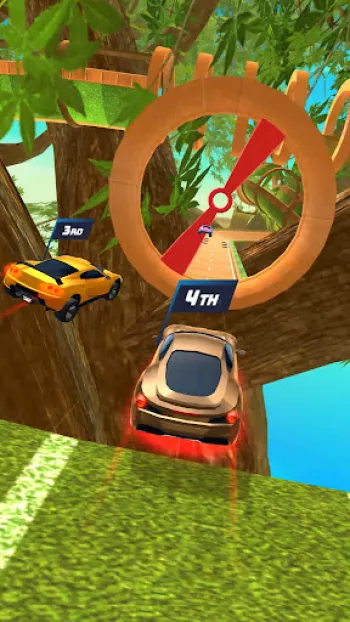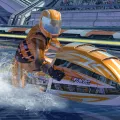Apps Zone

The Thrill of High-Speed Racing: An Unforgettable Automotive Experience
High-speed car racing is a captivating sport that marries the raw power of automotive engineering with the art of precision driving. This combination creates an electrifying experience for both drivers behind the wheel and the spectators who watch in awe. The allure of racing is deeply rooted in its ability to push the boundaries of what's possible, challenging drivers to test their reflexes, skills, and instinct under pressure. It's an arena where physics and mechanics come alive, turning theoretical speed and power into living, breathing adrenaline as drivers jostle for supremacy on the track. Each element of a race—from the perfectly engineered tarmac to the meticulously tuned cars—plays a pivotal role in shaping the outcome. Racing drivers, often seen as gladiators of the modern era, learn to master these elements, becoming one with their machines. The craftsmanship that goes into creating race cars is as much an art as it is a science. Every car must be ideally balanced for weight distribution, optimized for aerodynamics, and capable of reaching formidable speeds within the constraints of safety and practicality. Engineers work tirelessly to refine every component, from the tires that grip the asphalt to the high-performance engines that roar with life. At the same time, drivers undergo rigorous training to enhance their response times, decision-making skills, and knowledge of racecraft, all essential attributes needed to succeed at speeds that defy conventional limitations. The spectacle of high-speed car racing extends beyond the racetrack; it embodies a larger cultural phenomenon where technology, bravery, and human endurance intertwine to create a visceral spectacle of velocity and excitement. For many aficionados, high-speed races are not only about speed but also about strategy. Every race is a chess game played at hundreds of kilometers per hour, where knowing when to make a move can be as critical as the ability to execute it. As racing continues to evolve, both technology and human capabilities are constantly pushed to their limits, ensuring that the thrill of high-speed car racing remains an unforgettable experience for all those who partake in or witness its fury.
The Mechanics: Fine-Tuning Excellence in Race Car Engineering
The art of engineering race cars requires a symbiotic relationship between cutting-edge technology and meticulous craftsmanship. To create these masterpieces of speed, engineers must focus on myriad components that work in tandem to achieve maximum performance. At the heart of these vehicles lies the engine, the powerhouse that propels the car forward. High-performance engines in race cars are designed to deliver unparalleled power through advanced technologies such as turbocharging, direct fuel injection, and sophisticated electronic control systems. These engines are often constructed from lightweight materials like carbon fiber and titanium, allowing them to withstand the intense conditions of racing. Every component within the engine must be optimally calibrated to achieve the precise balance of power, efficiency, and reliability. Aerodynamics plays a crucial role in ensuring that the car maintains speed and stability. Engineers design the body of the car to reduce drag while optimizing downforce, crucial for maintaining grip on the track. Detailed wind tunnel testing helps to refine these designs, allowing engineers to achieve the perfect balance between speed and control. The chassis of the car is another vital element requiring precision and strength. Constructed with lightweight yet robust materials, it provides the foundation for all other components and must be rigorously tested to ensure it can withstand the physical demands during a race. Suspension systems are carefully designed to provide the driver with exceptional handling capabilities, ensuring the car remains responsive at high speeds and varied track conditions. Meanwhile, the braking system, often one of the most overlooked aspects of race car design, is critical to performance, requiring advanced technology to provide effective slowing power without sacrificing speed or control. Racing tires, manufactured to adhere to specific temperature ranges and track types, are engineered for maximum grip. In the world of racing, every small advantage matters, and the fine-tuning of these intricate systems is what separates the good from the great. The beauty of race car engineering lies in its ability to push technological innovation while remaining attuned to the practical needs of speed and performance, a pursuit that continues to inspire awe and admiration in fans worldwide.
Strategic Maneuvering: The Art of Racecraft and Driver Skill
The essence of high-speed car racing isn't solely about the power under the hood; it is equally about the skill and strategy displayed by the driver at the helm. The concept of racecraft is integral to understanding the nuances that define a truly skilled racer. Racecraft involves more than just driving fast—it's about knowing when and how to execute maneuvers that optimize track position, speed, and ultimately, victory. Drivers must possess a deep understanding of the track layout, including every curve, chicane, and straightaway, enabling them to anticipate how they and their competitors will navigate these challenges. The knowledge of braking points and the optimal racing line often distinguish the competent drivers from the extraordinary ones. These factors determine not only the speed at which one navigates a corner but also the acceleration out of it. A skillful driver knows how to leverage the slipstream behind competitors to gain precious speed while conserving fuel, and when to make aggressive passes without succumbing to the risk of a catastrophic crash. Racecraft also involves a psychological element—sensing other drivers' intentions, staying immune to pressure, and knowing how to influence the dynamics of the race. The ability to remain calm under intense pressure and make split-second decisions requires a combination of natural talent, rigorous training, and experience. Drivers also rely on real-time data, relayed to them via advanced telemetry systems, to make informed decisions throughout the race. This data includes information on fuel consumption, tire wear, and engine performance, enabling drivers to adjust their tactics dynamically. Pit stop strategy is another crucial aspect, where timing is everything, and teams must decide whether to go for a quick tire change or refuel during pivotal moments. Thus, racing strategy doesn't end when the car passes the starting line; it remains in flux, demanding constant adaptability and shrewdness. Understanding the interplay between maintaining consistent lap times, calculating risks, and managing race-efforts makes for a gripping narrative, one where age-old tactical wisdom meets state-of-the-art technology. Ultimately, the mastery of racecraft and strategic execution transforms what could be merely a mechanical display of speed into a captivating spectacle of human ingenuity and determination.
Global Racing Circuits: The Diverse Arenas of High-Speed Competitions
High-speed car racing wouldn't be the enduring spectacle it is without the diversity of circuits that stretch across the globe, each offering unique challenges and requiring its own level of strategic adaptability. These racing arenas, found in countries far and wide, range from purpose-built tracks with state-of-the-art facilities to exhilarating street circuits carved from the fabric of bustling cities. Each circuit has its own character, created from the blend of physical layout, geographical location, and cultural backdrop. From the twisting roads of Monaco's street circuit, which demands precision and bravado, to the legendary asphalt of Germany's Nurburgring, known for its treacherous corners and unpredictable weather, these tracks test not only the cars' engineering but the racers' skill and endurance. Racing venues like Italy's Monza, often referred to as the 'Temple of Speed,' require maximized power output and aerodynamics to conquer its long straights. In contrast, Brazil's Interlagos demands traction and cornering finesse, challenging drivers with its elevation changes and twisty sections. American circuits, like Circuit of The Americas, introduce intricacies with complex corners and overtaking opportunities, mirroring the elaborate and diverse landscapes of their surroundings. Such variations require racers and their teams to prepare meticulously, often adjusting setups and strategies uniquely suited for each event. This highlights the importance of flexibility and collaboration between driver and team, as they must adapt to diverse environments and conditions, from high-altitude circuits to those positioned in hot, humid climates, affecting engine efficiency and tire performance. Therefore, to excel across different racing circuits, teams invest heavily in pre-race simulations and analyses, allowing them to anticipate a multitude of factors—from tire degradation rates to fuel load strategies—in relation to each specific track. As a result, global racing circuits offer more than just a backdrop for speed; they serve as cultural exchanges where different driving styles and strategies meet, forge international rivalries, and establish the battlegrounds for heart-stopping motorsport drama, escalating the stakes and the allure of racing competitions worldwide.
A New Era of Racing: Technology, Simulation, and How to Engage
The world of high-speed car racing is swiftly evolving, with technology playing an ever-increasing role in shaping its future. At the forefront of this evolution is the incorporation of advanced simulations and cutting-edge technologies that allow drivers and teams to perfect their performances before even setting foot on a racetrack. These technological innovations include virtual reality (VR) setups and sophisticated simulation software that enable racers to experience and practice a track in a virtual environment under realistic conditions. Such simulations provide invaluable insights into car behavior under different conditions, helping drivers hone their race tactics and vehicle handling. This revolutionary approach to training also allows teams to gather extensive data that they can analyze to improve car setups and strategies. Furthermore, the digitalization of racing has opened up unprecedented opportunities for fan engagement. Through live telemetry data streaming, virtual spectators can receive updates on car diagnostics, driver biometrics, and real-time race statistics, transforming how audiences experience races and interact with the sport. This increased accessibility has broadened the reach of racing, drawing in new fans and fostering a community that spans the globe. Mobile gaming has further extended the experience into the everyday lives of fans, with exciting racing games available right at their fingertips. For enthusiasts looking to immerse themselves in high-octane action, "Race Master 3D" is an exhilarating mobile racing game available for Android. By delivering fast-paced, intuitive game mechanics combined with challenging tracks and customizable vehicles, it offers a thrilling and immersive racing experience directly on their devices. This game exemplifies how digital platforms have democratized access to the thrill of car racing, enabling fans to engage with the sport in novel ways. As technology continues to advance, the scope and scale of high-speed car racing will inevitably expand, promising to usher in an era where innovation informs tradition, and where racing continues to captivate hearts and minds both on and off the track. Through practical simulations and accessible gaming experiences, racing stands as a testament to human ingenuity and continues to thrive in an increasingly connected world. Whether on the raceway or through a touchscreen, the excitement and allure of speed remain relentless, inviting all to dive into their passions and be part of the sport's legacy.
Share Your Opinion
Your Email Will Not Be Published.
All Rights Reserved © Apps Zone 2025










































Mark Ssebuliba
Race Master 3D is a fantastic mobile racing game that excels in delivering high-speed, obstacle-based fun. Its simple controls, dynamic tracks, and...
Matthew Gutierrez
Great simple arcade racing game. It's everything I ever wanted and it's played vertically, so people won't know you're playing a game. The basic co...
Will Kelley
Love this game. The fact that it does not break the race with commercials like so many other racing games is great. Most commercials are fast. On l...
Alexander Jetter
This is the best race game I've ever played. Not only are the graphics better than most, but there is great gameplay due to most races being a grea...
Amber Animations
I give this game a 10 out of 10! Aside from the annoying ads popping up every time, 😒 I enjoy the levels, races, and tracks in here! I have a lot ...